




Your support is critical to our success.
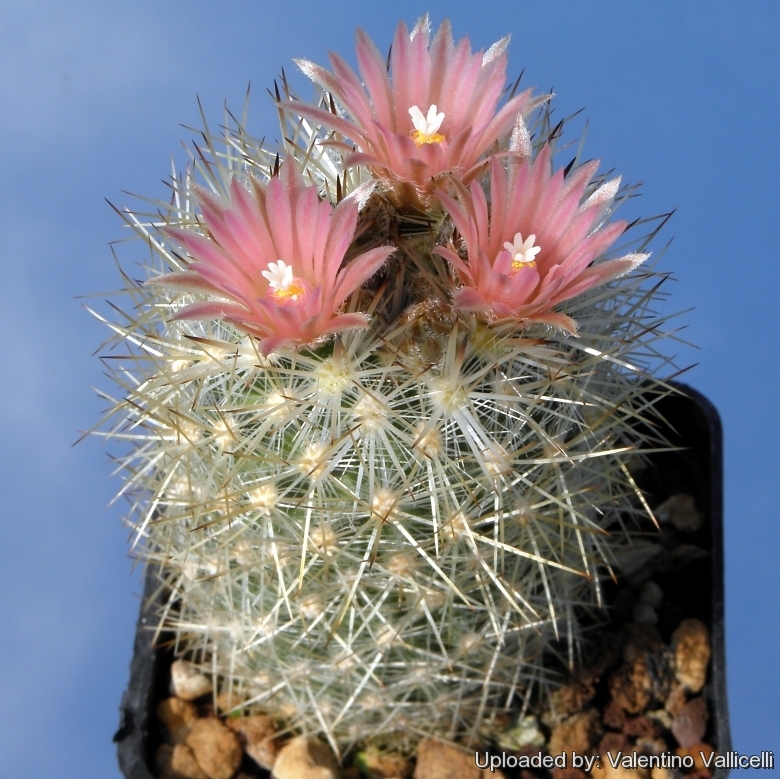
Origin and Habitat: endemic to New Mexico, Doña Ana County, in northern Franklin and the southern part of the Organ Mountains.
Altitude: 1350-2600 metres above sea level.
Habitat: Escobaria organensisSN|10363]]SN|10363]] grows in small clusters in rugged and inaccessible areas and often forms large patches in crevices on the rocky limestone walls of canyons or scattered along ridgelines. It is easily observed throughout the year, because they are not hidden by heavy grass cover. Associated mostly with Chihuahuan desert scrub and open oak and piñon-juniper woodland.
Synonyms:
- Escobaria organensis (Zimmerman) Castetter, P.Pierce & K.H.Schwer.
- Coryphantha organensis Zimmerman
ENGLISH: Organ Mountain Foxtail Cactus
Description: Escobaria organensisSN|25139]]SN|10363]] is a small clustering cactus species, with spines obscuring the stem and giving the plant a yellow appearance. Blooms are pink.
Habit: It grow solitary or more commonly in loosely packed clumps, usually with about 10 heads per cluster, but sometime with as many as 50 heads in a single clump.
Stems: Individual stems globular to cylindric,soft, 2-4(-7) cm in diameter, to 12(-15) cm tall.
Tubercles: 7-10 mm long with upper surface bearing a groove in adult specimens.
Spines: About 20-60 per areole, majority slender and bristle-like to about 10 mm long and spreading.
Central spines: Stout, straight, tan to golden yellow, tips often reddish brown, about 10-20(-25) mm long, inner central spines 0 to 4 (usually 1) per areole, outer central spines 8 to 14 per areole, subequal.
Radial spines: 37 to 49 per areole, white, fine, stiff, straight, spines are usually not completely obscuring underlying tubercles.
Flowers: Pink (usually), pale yellowish or nearly white, often with midribs darker, not opening widely, about up to 2,5 cm long (usually smaller 1,4-1,5 mm), outer perianth parts fringed. Stigmas white to pink.
Fruits: Cylindric, yellowish green to somewhat reddish, up to 6-14(-20) mm long, perianth parts persistent.
Phenology: Flowering occurs in spring (May to June in habitat). Fruit are persistent into autumn.
Seeds: About 1 mm long, kidney-shaped with hilum lateral, pitted, brown.
Similar Species: It is similar and closely related to Escobaria sneediiSN|10363]]SN|10397]] but it has darker central spines and a large average stem diameter, these two species intergrades in the northern Franklin Mountains. It is also related with Escobaria tuberculosaSN|10397]]SN|10187]] that usually has more richly coloured flowers that open widely, fruits that ripen bright red, and seeds that are smaller and rounder. The yellowish cast to the spines distinguishes Escobaria organensisSN|10363]]SN|10363]] from other members of the Escobaria sneediiSN|10187]]SN|10397]] Complex. Escobaria organensisSN|10397]]SN|10363]] is also difficult to distinguish from Escobaria sandbergiiSN|10363]]SN|25139]] that occurs in the San Andres Mountains to the north.
Subspecies, varieties, forms and cultivars of plants belonging to the Escobaria sneedii group
 Escobaria organensis (Zimmerman) Castetter, P.Pierce & K.H.Schwer.: it is less white with central spines yellow, tips often reddish brown and has a large average stem diameter. Distribution: Northern Franklin Mountains and the southern part of the Organ Mountains. New Mexico.
Escobaria organensis (Zimmerman) Castetter, P.Pierce & K.H.Schwer.: it is less white with central spines yellow, tips often reddish brown and has a large average stem diameter. Distribution: Northern Franklin Mountains and the southern part of the Organ Mountains. New Mexico. Escobaria sneedii Britton & Rose: has 6-20 central spines white with dark tips up to 30 mm long, radials 20-55 bristle-like white. Flowers pink. Distribution: Franklin Mountains (west Texas) and Florida and Guadalupe Mountains (southern New Mexico).
Escobaria sneedii Britton & Rose: has 6-20 central spines white with dark tips up to 30 mm long, radials 20-55 bristle-like white. Flowers pink. Distribution: Franklin Mountains (west Texas) and Florida and Guadalupe Mountains (southern New Mexico). Escobaria sneedii subs. leei (Rose ex Boed.) D.R.Hunt: has 30-90 radial spines about 1-2,5 mm long, white often brown at tip, sometimes with one to few short centrals. It is a neotenic form of Escobaria sneedii. Distribution: Eddy County, Guadalupe Mountains, New Mexico.
Escobaria sneedii subs. leei (Rose ex Boed.) D.R.Hunt: has 30-90 radial spines about 1-2,5 mm long, white often brown at tip, sometimes with one to few short centrals. It is a neotenic form of Escobaria sneedii. Distribution: Eddy County, Guadalupe Mountains, New Mexico.
Bibliography: Major references and further lectures
1) Ellen A. Debruin “Surveys and Habitat Analyses of Five Rare Plant Species In the Organ Mountains of New Mexico” In: “Southwestern Rare and Endangered Plants: Proceedings of the Second Conference” DIANE Publishing. 1995
2) Zimmerman, A.D. “Systematics of the genus Coryphantha (Cactaceae).” Dissertation, University of Texas, Austin. 1985
3) Zimmerman, D.A. “A new species of Coryphantha from New Mexico.” in: Cactus and Succulent Journal (U.S.) 44(3):144. 1972
4) Edward Anderson “The Cactus family” Timber Press, Incorporated, 2001
5) James Cullen, Sabina G. Knees, H. Suzanne Cubey "The European Garden Flora Flowering Plants: A Manual for the Identification of Plants Cultivated in Europe, Both Out-of-Doors and Under Glass" Cambridge University Press, 11/Aug/2011
6) David R Hunt; Nigel P Taylor; Graham Charles; International Cactaceae Systematics Group. "The New Cactus Lexicon" dh books, 2006
7) Castetter, E.F., P. Pierce and K.H. Schwerin. “A reassessment of the genus Escobaria” in: Cactus and Succulent Journal (U.S.) 47:60-70. 1975
8) Flora of North America Editorial Committee. “Flora of North America, volume 4” Oxford University Press, New York. 2003.
9) New Mexico Native Plants Protection Advisory Committee. “A handbook of rare and endemic plants of New Mexico.” University of New Mexico Press, Albuquerque. 1984
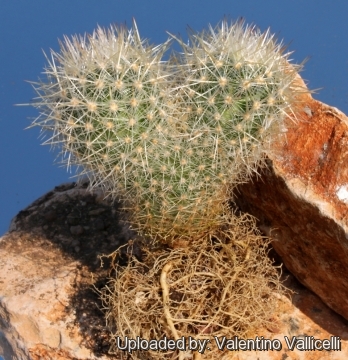
Escobaria organensis Photo by: Valentino Vallicelli
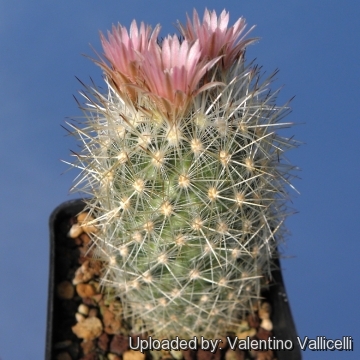
Escobaria organensis Photo by: Valentino Vallicelli
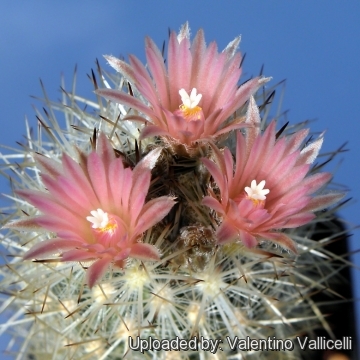
Escobaria organensis Photo by: Valentino Vallicelli
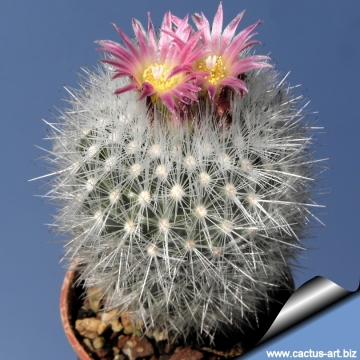
Escobaria organensis Photo by: Cactus Art
Cultivation and Propagation: Escobaria organensisSN|10363]]SN|10363]] comes from an area of summer rainfall and is supposed to be not the most easiest species in cultivation, as particularly sensible to moisture excesses. It will offset profusely.
Soils: Use a an open and free draining mineral compost with little organic matter (peat, humus) that allows therefore roots to breath (as it is rot prone).
Repotting: Repotting every 2-3 years. Use a small pot with good drainage.
Watering: It likes a winter's rest and should be kept completely dry during the winter months. From early spring onwards the plant will begin to grow and watering should be increased gradually until late spring when the plant should be in full growth. Water regularly during the summer so long as the plant pot is allowed to drain and not sit in a tray of water. During hot weather you may need to water the plants more frequently so long as the plant is actively growing. From late summer watering should be reduced to force the plant to go in to a state of semi dormancy, by autumn you should be back in to the winter watering regime. Keep dry with ample airflow in winter (but for outdoors cultivation it is very resistant to wet conditions, too). In the rest period no high atmospheric humidity!! Care must be taken with watering as they tends to become swollen and untidy in growth habit if given too much water and shade.
Fertilization: Feed with a high potassium fertilizer in summer.
Hardiness: Reputedly resistant to frost if kept on the dry side prior to, and during, cold weather (hardy to -17 C ° C, or less for short periods).
Exposition: The plant tolerates very bright situations, if kept too dark they may become overly lush and greener and could be prone to rotting due to over watering. Strong light encourages flowering and heavy wool and spine production, but is likely to suffer from sun scorch or stunted growth if over exposed to direct sunlight during the hottest part of the day in summer. .
Uses: It is an excellent plant for container growing. It always looks good and stays small. It look fine in a cold greenhouse and frame or outdoor in a rockery.
Pests & diseases: It may be attractive to a variety of insects, but plants in good condition should be nearly pest-free, particularly if they are grown in a mineral potting-mix, with good exposure and ventilation. Nonetheless, there are several pests to watch for:
- Red spiders: Red spiders may be effectively rubbed up by watering the plants from above.
- Mealy bugs: Mealy bugs occasionally develop aerial into the new growth among the wool with disfiguring results, but the worst types develop underground on the roots and are invisible except by their effects.
- Scales: Scales are rarely a problem.
- Rot: This species seldom suffer of cryptogamic diseases. Rot it is only a minor problem with cacti if the plants are watered and “aired” correctly. If they are not, fungicides won't help all that much.
Propagation: Direct sow after last frost or usually by offsets (readily available), or occasionally grafted. Seeds (no dormancy requirement) germinate in 7-14 days at 21-27° C in spring, remove gradually the glass cover as soon the plants will be well rooted (ca 1-2 weeks) and keep ventilated, no full sun for young plants! The seedlings should not be disturbed until they are well rooted, after which they can be planted separately in small pots. Cuttings: wait until the offsets that appear at the base of old clustered specimens are 1/3 the size of the parent and then detach and plant.
| Your Actions | |
|---|---|
| Back to Escobaria index | |
| Back to Cactaceae index | |
 |
Back to Cacti Encyclopedia index |
Privacy stantement - Terms and conditions - How to cite - About us - Feedback - Donate



